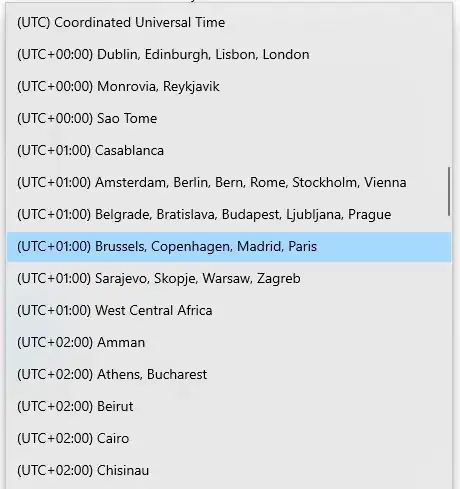Not sure if superuser.com is the proper StackExchange site to ask this question; if not, refer me to the most appropriate of the sites.
What is the origin of the time zones that come with Windows? For the sake of example, I shall list some here (from using PowerShell, but the info is not .NET-specific):
PS C:\Users> [TimeZoneInfo]::FindSystemTimeZoneById("W. Europe Standard Time")
Id : W. Europe Standard Time
HasIanaId : False
DisplayName : (UTC+01:00) Amsterdam, Berlin, Bern, Rome, Stockholm, Vienna
StandardName : W. Europe Standard Time
DaylightName : W. Europe Daylight Time
BaseUtcOffset : 01:00:00
SupportsDaylightSavingTime : True
PS C:\Users> [TimeZoneInfo]::FindSystemTimeZoneById("Central Europe Standard Time")
Id : Central Europe Standard Time
HasIanaId : False
DisplayName : (UTC+01:00) Belgrade, Bratislava, Budapest, Ljubljana, Prague
StandardName : Central Europe Standard Time
DaylightName : Central Europe Daylight Time
BaseUtcOffset : 01:00:00
SupportsDaylightSavingTime : True
PS C:\Users> [TimeZoneInfo]::FindSystemTimeZoneById("Romance Standard Time")
Id : Romance Standard Time
HasIanaId : False
DisplayName : (UTC+01:00) Brussels, Copenhagen, Madrid, Paris
StandardName : Romance Standard Time
DaylightName : Romance Daylight Time
BaseUtcOffset : 01:00:00
SupportsDaylightSavingTime : True
PS C:\Users> [TimeZoneInfo]::FindSystemTimeZoneById("Central European Standard Time")
Id : Central European Standard Time
HasIanaId : False
DisplayName : (UTC+01:00) Sarajevo, Skopje, Warsaw, Zagreb
StandardName : Central European Standard Time
DaylightName : Central European Daylight Time
BaseUtcOffset : 01:00:00
SupportsDaylightSavingTime : True
All these four entries ("W. Europe Standard Time", "Central Europe Standard Time", "Romance Standard Time", "Central European Standard Time") are essentially equivalent, but confusing in several ways. Here are some examples:
- The name W. Europe Standard Time is often used for UTC±00:00 used in Lisbon, London etc., so where does the name come from?
- The word Romance in the third one is curious. One city mentioned (Copenhagen) uses a non-Romance language (Danish, a Germanic language), while a city with clearly Romance association (Rome, from the name of which Romance is derived) is in another entry.
- There is no meaning to the groups. Like why are Amsterdam and Brussels in different groups? And why does Stockholm go together with Amsterdam while Copenhagen goes with Brussels?
- If you are in Oslo (not mentioned), would you pick Copenhagen or Stockholm?
- The names Central Europe Standard Time and Central European Standard Time are very similar? Why is Zagreb not grouped together with Ljubljana; the cities of the Balkans are completely randomly distributed between the two groups?
So my main question is, what is the explanation for these groups? Is there a map from tz database entries to the groups used by Windows?
